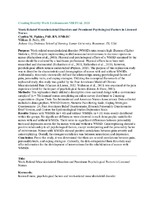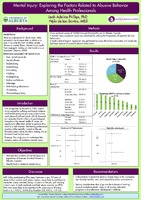Risk perception, safe work behavior, and work-related musculoskeletal disorders among critical care nurses
View File(s)
Visitor Statistics
Visits vs Downloads
Visitors - World Map
Top Visiting Countries
| Country | Visits |
|---|
Top Visiting Cities
| City | Visits |
|---|
Visits (last 6 months)
Downloads (last 6 months)
Popular Works for Lee, Soo Jeong by View
| Title | Page Views |
|---|
Popular Works for Lee, Soo Jeong by Download
| Title | Downloads |
|---|
View Citations
Citations
The citations below are meant to be used as guidelines. Patrons must make any necessary corrections before using. Pay special attention to personal names, capitalization, and dates. Always consult appropriate citation style resources for the exact formatting and punctuation guidelines.
Item Information
Item Link - Use this link for citations and online mentions.
Abstract
Background. Work-related musculoskeletal disorders (WRMSDs) are a major occupational health problem among nurses. Existing interventions have not totally eliminated the risk for WRMSDs. Safe work behavior and risk perception may play an important role in modifying this risk.
Objectives. The aims of the study were to identify factors influencing safe work behaviors related to patient handling and risk perceptions about risk of musculoskeletal injury among critical care nurses; and examine the relationship between safe work behavior and risk perception.
Methods. A cross-sectional national survey was conducted using a random sample of 1000 members of the American Association of Critical Care Nurses. A total of 412 registered nurses participated in the study, and 361 subjects served as the sample for the data analysis. Nurses reported on the physical, psychosocial, and organizational characteristics of their jobs and on their work behaviors, musculoskeletal symptoms, risk perception, and demographics using a mailed questionnaire.
Findings. Multiple linear regressions revealed that significant predictors for safer work behavior included better safety climate, higher effort-reward imbalance, less overcommitment, greater social support, and day shifts (versus rotating shifts). These five predictors explained 20% of the variance in safe work behavior. Significant predictors for greater risk perception of musculoskeletal injury included greater job strain, higher physical workload index, more frequent patient handling, higher musculoskeletal symptom index, and lack of lifting devices or lifting teams. These five predictors explained 23% of the variance in risk perception of musculoskeletal injury. Nurses' perceived risk of musculoskeletal injury showed a weak inverse association with safe work behavior that was statistically significant in bivariate analysis (r=-.13, p=.01), but not in the multivariate model (β=-.02, p=.75).
Conclusion. Safe work behaviors and risk perception are best understood as socio-cultural phenomena influenced by organizational, psychosocial, and physical job characteristics. Management efforts to enhance the organizational safety climate and improve stressful job conditions could prove to be crucial in promoting nurses' safe work behavior. Further research is needed to determine the role of safe work behavior and risk perception in nurses' safety and health. The unexpected positive association of effort-reward imbalance with safer behavior should also be further investigated.
Description
This dissertation has also been disseminated through the ProQuest Dissertations and Theses database. Dissertation/thesis number: 3286660; ProQuest document ID: 304880161. The author still retains copyright.
Repository Posting Date
2020-09-04T19:13:27Z
Notes
This item has not gone through this repository's peer-review process, but has been accepted by the indicated university or college in partial fulfillment of the requirements for the specified degree.
Type Information
| Type | Dissertation |
| Acquisition | Proxy-submission |
| Review Type | None: Degree-based Submission |
| Format | Text-based Document |
Category Information
| Evidence Level | Cross-Sectional |
| Research Approach | Quantitative Research |
| Keywords | Repetitive Use Injury; Nurses; Workforce Health |
| CINAHL Subject(s) | Musculoskeletal System; Occupational-Related Injuries; Attitude to Risk; Critical Care Nursing; Musculoskeletal System--Injuries; Occupational-Related Injuries--Prevention and Control |
Degree Information
| Grantor | University of California, San Francisco |
| Advisor | Faucett, Julia |
| Level | PhD |
| Year | 2007 |
Rights Holder
All rights reserved by the author(s) and/or publisher(s) listed in this item record unless relinquished in whole or part by a rights notation or a Creative Commons License present in this item record.
All permission requests should be directed accordingly and not to the Sigma Repository.
All submitting authors or publishers have affirmed that when using material in their work where they do not own copyright, they have obtained permission of the copyright holder prior to submission and the rights holder has been acknowledged as necessary.
Related items
Showing items related by title, author, creator and subjects.
-
Psychological factors and work-related musculoskeletal disorders in nurses: A comparative secondary analysis
Perry, William B.; Pipkins, Cynthia M.Work-related musculoskeletal disorders (WMSDs) continue to occur at a high rate in nurses despite various interventions implemented for safe patient handling. Psychological effects of a WMSD sustained are understudied. ... -
Work-related musculoskeletal disorders: Psychological factors in licensed nurses
Pipkins, Cynthia M. (2017-09-15)Licensed nurses complain of pain and leave the profession citing work-related musculoskeletal disorders (WMSD). Psychological factors affect injury response of avoidance or confrontation. Explore the self-reported ... -
Work-related musculoskeletal disorders and prominent psychological factors in licensed nurses
Pipkins, Cynthia M.; Perry, William B.Work-related musculoskeletal disorder (WMSD) rates remain high despite implementing multidimensional interventions to decrease injuries in nurses. Psychological effects of a WMSD sustained by the nurse should be evaluated ... -
Mental injury: Exploring the factors related to abusive behavior among health professionals
Phillips, Leah Adeline (2017-07-21)Purpose: In Canada, Licensed Practical Nurses (LPNs) are a self - regulated profession; they are accountable to the public, the profession, to other members of the healthcare team, and to their employers. LPNs work as part ... -
Perceived challenges to prevention of work-related conflicts among nurse leaders in teaching hospital, Calabar, Nigeria
Akpabio, Idongesit I.; Nyambi, Cecelia ObalWork related conflicts (WRCs) often result in grave consequences if not properly managed. Nursing is driven by the need to provide high quality care. This study examined nurse leaders’ perceived challenges to prevention ...





